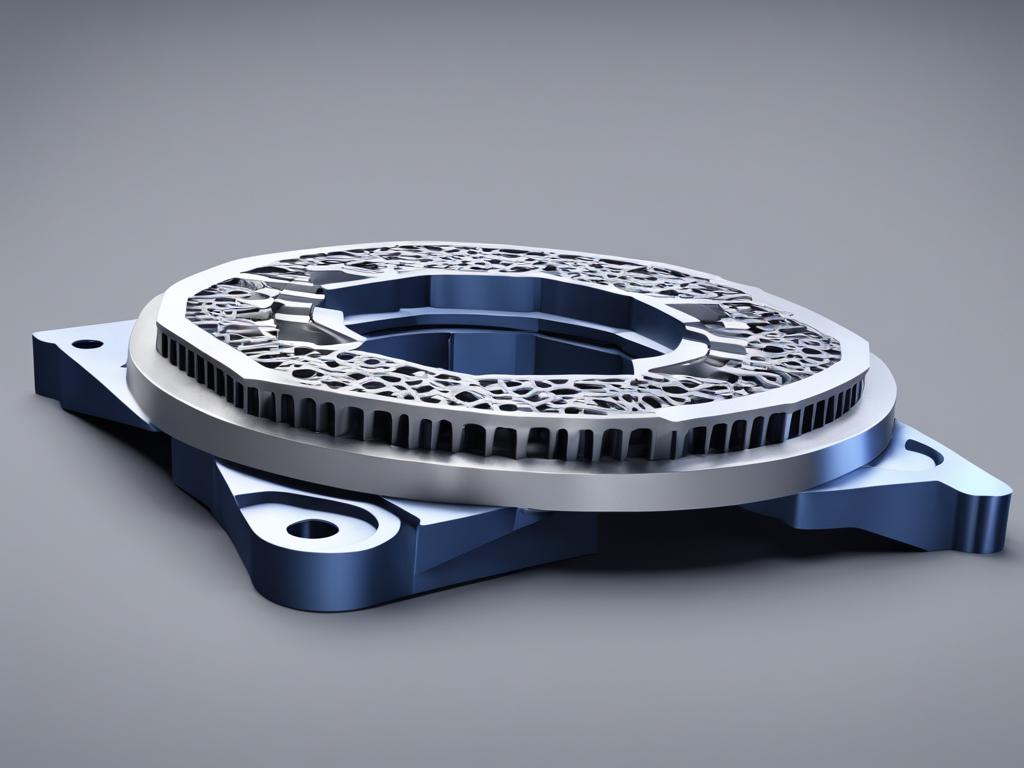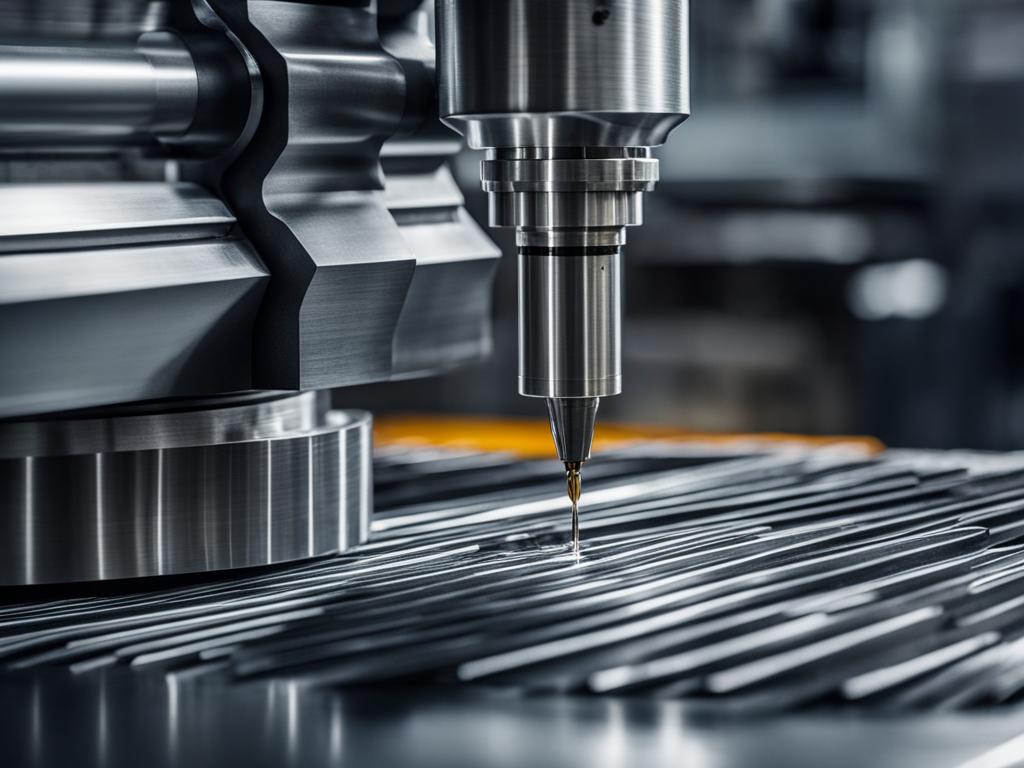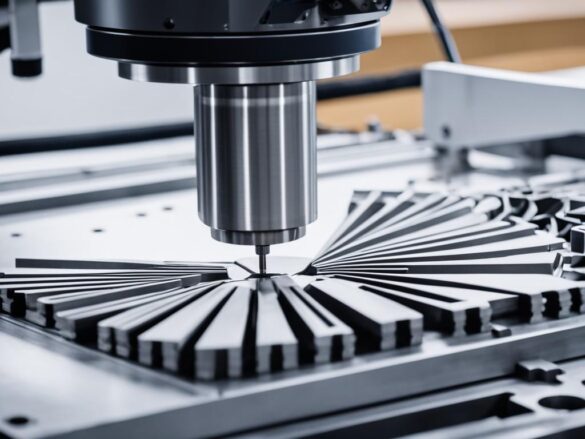CNC machining is a highly efficient manufacturing method for producing custom parts with intricate designs. By optimizing your part design for CNC machining, you can achieve increased manufacturing efficiency and precision. In this article, I will explore seven strategies to optimize your part design, providing you with the knowledge and techniques to save time, reduce costs, and achieve optimal performance in your CNC machining projects.
Key Takeaways:
- Utilize round internal corners for better milling performance.
- Limit the depth of holes to four times their diameter for precise machining.
- If feasible, split up complex parts into multiple components for faster machining.
- Avoid exceeding the optimum depth of cutting tools to maintain accuracy.
- Eliminate unnecessary small features to save time and cost.
Why Choose CNC Machining for Your Parts?
CNC machining is a preferred manufacturing method for parts with complex designs, offering high precision and quality. Unlike other methods like die casting and injection molding, CNC machining provides numerous advantages that contribute to its popularity.
Firstly, CNC machining is suitable for a wide range of materials, including metal, wood, and plastic. This material flexibility allows for diverse applications and ensures the right material choice for specific part requirements.
Secondly, CNC machining offers faster lead times compared to traditional manufacturing methods. The use of computer-controlled machines enables efficient production, reducing waiting time and increasing overall productivity.
Another key benefit is cost-effectiveness. CNC machining eliminates the need for expensive molds or tooling, resulting in lower upfront costs. Additionally, precise cutting and minimal waste contribute to cost savings in material utilization.
Overall, understanding the advantages of CNC machining and its application in part design optimization can help you make informed decisions and achieve optimal results in your manufacturing projects.

Comparing CNC Machining with Other Manufacturing Methods
| Manufacturing Method | Advantages of CNC Machining |
|---|---|
| Die Casting | – CNC machining offers more design flexibility and precision. |
| Injection Molding | – CNC machining provides quicker lead times and cost-effectiveness. |
How to Optimize CNC Machining Parts?
Optimizing part design for CNC machining is crucial for enhancing the efficiency and cost-effectiveness of the process. By implementing the following part design optimization techniques, you can achieve optimal results in your CNC machining projects:
- Rounding the Corners: Use round internal corners instead of sharp ones to improve milling performance.
- Hole Size and Depth: Utilize standard-size holes and limit the depth to four times their diameter for precise machining.
- Splitting Complex Parts: If feasible, divide complex parts with deep pockets into multiple components for faster machining.
- Cavity Depth: Avoid exceeding the optimum depth of cutting tools (2-3 times their diameter) to maintain accuracy.
- Unnecessary Small Features: Eliminate unnecessary small features to save time and cost.
- Thickness of Walls: Opt for a minimum wall thickness of 0.88mm for metal parts to ensure optimal machining results.
- Limit Tight Tolerance: Use tight tolerance only for critical features, while standard tolerance will suffice for other surfaces.
By following these part design optimization techniques, you can significantly enhance the performance and efficiency of your CNC machining parts. The next section will discuss the importance of choosing the right design for CNC machining.

Note: The image above visually represents the implementation of part design optimization techniques for CNC machining.
Choosing the Right Design for CNC Machining
Design considerations play a critical role in optimizing the CNC machining process. A well-constructed design is essential for successful part manufacturing. When choosing the right design, it is crucial to take the following factors into account:
- Emphasize Design Importance: Understanding the significance of a well-designed part is key. Consulting with professionals, such as design engineers or CNC machining experts, can provide valuable insights and ensure a design that maximizes manufacturing efficiency and performance.
- Optimize Before Production: Enhancing the design prior to manufacturing is a proactive approach that can yield significant benefits. By seeking guidance from your CNC machining partner, you can identify design improvements, optimize structural integrity, and reduce costs.
- Collaborate with Manufacturers: Working closely with your manufacturer is essential in selecting the best design, material, and machining process for your project. Their expertise and experience can help you make informed decisions, leading to precise and efficient manufacturing outcomes.
By applying these design considerations for CNC machining, you can ensure that your parts are well-suited for the manufacturing process, resulting in superior quality and performance.

| Factors to Consider for CNC Machining Design | Benefits |
|---|---|
| Well-constructed design | Successful part manufacturing |
| Professional consultation | Insights from experts |
| Design optimization | Enhanced structural integrity and reduced costs |
| Collaboration with manufacturers | Improved design, material, and manufacturing process selection |
Selecting the Right Manufacturer for CNC Machining
Choosing the right manufacturer is crucial to optimize your CNC machining project. When selecting a manufacturer for your CNC machining needs, consider the following aspects:
- Expertise and Tools: Ensure the manufacturer has skilled engineers and advanced tools to achieve optimal machining results. The expertise of the manufacturer’s team and the quality of their equipment directly impact the precision and efficiency of your CNC machining project.
- End-to-End Solutions: Look for a manufacturer that offers comprehensive services from design to surface finishing. Having a provider that can handle the entire machining process ensures seamless collaboration and eliminates the need for multiple vendors, streamlining your project.
- Sustainability and Cost-Effectiveness: A customer-centric manufacturer prioritizes minimizing wastage, defects, and overall cost to provide value and satisfaction to clients. Choosing a manufacturer that emphasizes sustainability and cost-effectiveness helps optimize your project’s budget while reducing environmental impact.
By carefully considering these factors when selecting a manufacturer, you can ensure a successful and efficient CNC machining experience that meets your design requirements and project goals.
Choosing the Right Material for CNC Machining
When it comes to optimizing the CNC machining process, selecting the right material for your parts is crucial. Consider the following guidelines to ensure efficient and high-quality results:
1. Hardness
Choose a material with suitable hardness to optimize tooling and machining parameters. The hardness of the material directly affects the performance and lifespan of cutting tools. Harder materials tend to have better wear resistance, allowing for more efficient machining processes.
2. Chip Formation
Consider the chip formation characteristics of different materials. Harder materials generally produce fewer chips during the machining process, leading to improved efficiency and cleanliness. Understanding how different materials behave during the machining process will help you select the most suitable material for your specific application.
3. Consultation
Seek guidance from your manufacturer to choose the most appropriate material for your specific requirements. Experienced manufacturers have extensive knowledge of various materials and can provide valuable insights and recommendations based on your project’s needs. Collaborating with experts ensures that you select a material that balances cost-effectiveness, performance, and machining feasibility.
| Material | Main Properties | Applications |
|---|---|---|
| Aluminum | Lightweight, good thermal and electrical conductivity | Aerospace, automotive, electronics |
| Stainless Steel | Corrosion resistance, high strength | Medical devices, food processing, automotive |
| Brass | Excellent machinability, low friction | Musical instruments, plumbing, decorative fittings |
Choosing the right material is a critical step in optimizing part design for CNC machining. By considering factors such as hardness, chip formation, and seeking expert consultation, you can ensure that your material selection aligns with your project goals and enhances the overall efficiency and performance of the CNC machining process.

Planning and Optimizing Tool Paths for CNC Machining
Planning and optimizing tool paths are crucial elements in achieving efficient CNC machining results. By strategically designing the paths taken by the cutting tool, you can optimize the part features and surface finish of your CNC machined parts. Here are three strategies to consider:
1. Path Design
When planning tool paths for CNC machining, it is important to ensure that the cutting tool follows a path that aligns with the desired part features and achieves the optimal surface finish. By carefully planning the tool’s movement, you can reduce material waste, minimize machining time, and improve overall part quality.
2. Stock Remaining
Another aspect to consider when optimizing tool paths is the amount of stock that should be left after each machining operation. Planning tool paths to leave adequate stock remaining allows for subsequent machining processes, such as finishing or secondary operations. This optimization strategy helps streamline the manufacturing process and minimizes material waste.
3. Surface Finish
The design of tool paths also plays a significant role in achieving the desired surface finish for your CNC machined parts. By carefully strategizing the tool’s movement and ensuring proper tool engagement with the workpiece, you can achieve the desired surface quality, texture, and precision. Consider factors such as cutting speeds, feed rates, and tool orientation when designing tool paths for optimal surface finish.

Implementing these strategies for planning and optimizing tool paths in CNC machining can result in enhanced part features and surface finishes, leading to higher quality and more efficient production. By maximizing the effectiveness of the machining process, you can achieve optimal performance and meet the design requirements of your CNC machined parts.
Reducing Cycle Time in CNC Machining
Reducing cycle time in CNC machining is crucial for achieving optimal part performance and optimizing part geometry. By minimizing cycle time, you can significantly improve production efficiency and maximize the benefits of CNC machining.
Factors to Consider for Minimizing Cycle Time
- Understanding Process Limitations: Familiarize yourself with the limitations of the CNC machining process to optimize accordingly. By understanding the capabilities and constraints of the machinery, you can make informed design decisions that reduce cycle time.
- Material Considerations: Different materials require varying machining speeds, which directly impact cycle time. Selecting the most suitable material for your specific parts and adjusting the machining parameters accordingly can help minimize cycle time.
- Efficiency vs. Surface Finish: Balancing between higher feed rates and lower feed rates is crucial in reducing cycle time. Higher feed rates prioritize productivity, while lower feed rates aim for a smoother surface finish. Finding the optimum balance between these two factors will help you achieve the desired cycle time without sacrificing the quality of your parts.
| Factor | Impact on Cycle Time |
|---|---|
| Understanding Process Limitations | Optimize according to machinery capabilities |
| Material Considerations | Select appropriate material and adjust machining parameters |
| Efficiency vs. Surface Finish | The balance between feed rates for productivity and surface quality |
By considering these factors and implementing efficient strategies, you can effectively reduce cycle time in CNC machining, improving your overall production efficiency and achieving optimal part performance.
Conclusion
Optimizing the design of your parts is crucial for enhancing the efficiency and cost-effectiveness of CNC machining. By implementing the strategies discussed in this article, you can achieve optimal performance in your CNC machining projects. Collaborating with experienced manufacturers like [Brand Name] who have the expertise and tools can further enhance your results.
Consideration of material selection, design optimization, tool paths, cycle time, and tolerance requirements are essential for successful part design in CNC machining. By roundinthe corners, selecting appropriate hole sizes and depths, and splitting complex parts when necessary, you can improve milling performance and save time.
Additionally, paying attention to cavity depth, eliminating unnecessary small features, and optimizing wall thickness will result in accurate and cost-effective CNC machining. By choosing the right design, collaborating with manufacturers, and consulting with professionals, you can ensure that your part design is optimized for CNC machining, ultimately maximizing the benefits and efficiency of the manufacturing process.
FAQ
What is CNC machining?
CNC machining is a manufacturing method that uses computer-controlled machines to shape and create custom parts from various materials, such as metal, wood, and plastic. It offers high precision, fast lead times, and cost-effectiveness compared to other manufacturing processes.
Why should I choose CNC machining for my parts?
CNC machining is preferred for parts with complex designs due to its high precision and quality. It offers faster lead times, material flexibility, and cost-effectiveness compared to other methods like die casting and injection molding.
How can I optimize CNC machining parts?
To optimize CNC machining parts, you can implement strategies such as rounding the corners, using standard hole sizes and depths, splitting complex parts, avoiding excessive cavity depths, eliminating unnecessary small features, optimizing wall thickness, and using tight tolerances only for critical features.
What design considerations should I keep in mind for CNC machining?
When designing for CNC machining, it is important to emphasize the importance of a well-designed part, optimize the design before production, and collaborate closely with the manufacturer to select the best design, material, and machining process for your project.
How do I choose the right manufacturer for CNC machining?
When selecting a manufacturer for CNC machining, consider their expertise, tools, and capabilities, look for a provider of end-to-end solutions from design to surface finishing, and prioritize sustainability and cost-effectiveness to ensure value and satisfaction.
What factors should I consider when choosing the material for CNC machining?
When choosing a material for CNC machining, consider factors such as hardness to optimize tooling and machining parameters, chip formation for efficiency and cleanliness, and consult with your manufacturer to select the most appropriate material for your specific requirements.
How do I plan and optimize tool paths for CNC machining?
To plan and optimize tool paths for CNC machining, ensure that the cutting tool’s path aligns with the desired features and surface finish, plan for enough remaining stock for subsequent machining processes, and design tool paths that achieve the desired surface finish for your parts.
How can I reduce cycle time in CNC machining?
To reduce cycle time in CNC machining, familiarize yourself with the process limitations, consider material considerations that affect machining speeds, and find a balance between higher feed rates for smoother surface finish and lower feed rates for productivity.
How can part design optimization enhance CNC machining?
Part design optimization can enhance CNC machining by increasing manufacturing efficiency, reducing costs, and achieving optimal performance. By implementing the recommended strategies and collaborating closely with manufacturers, you can maximize the benefits of CNC machining for your projects.



